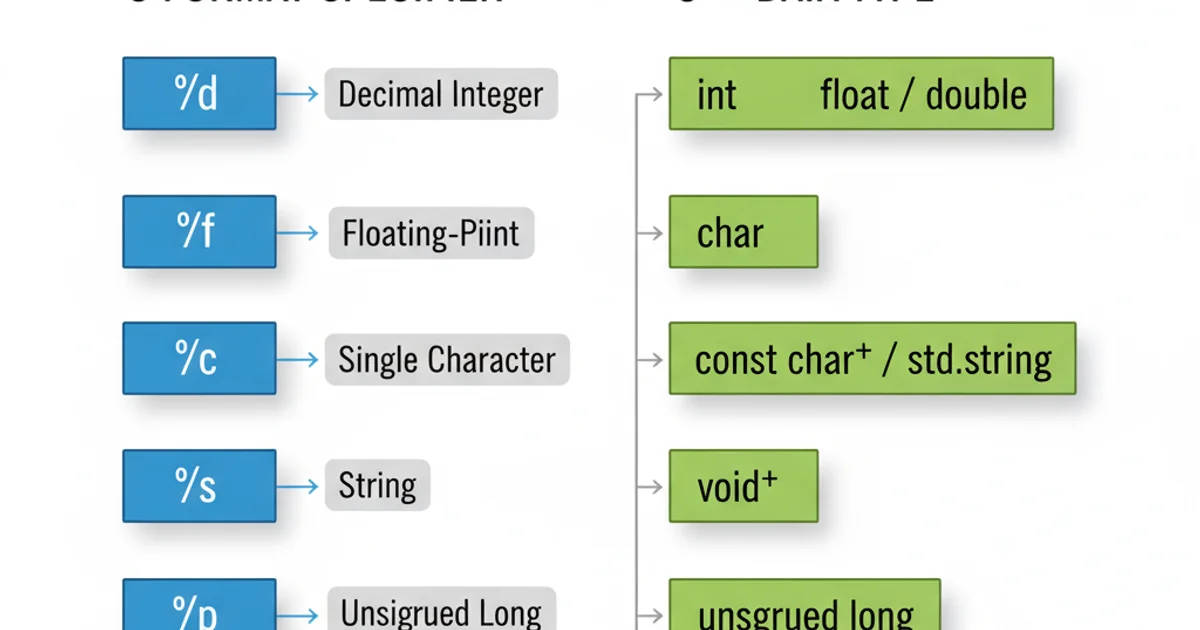Using various format specifiers of c in c++
Categories:
Mastering Format Specifiers in C++ for C-style I/O

Explore the essential C-style format specifiers in C++ for precise control over input and output operations, enhancing your understanding of printf, scanf, and related functions.
While C++ offers powerful, type-safe I/O streams (std::cout, std::cin), there are many scenarios where C-style I/O functions like printf and scanf are still prevalent. This is especially true when working with legacy codebases, interacting with C libraries, or when fine-grained control over output formatting is required. Understanding format specifiers is crucial for correctly using these functions, preventing common errors, and ensuring your data is displayed or parsed as intended.
Understanding Basic Format Specifiers
Format specifiers are placeholders within a format string that tell functions like printf and scanf what type of data to expect and how to interpret or display it. They begin with a percent sign (%) followed by one or more characters that define the data type and formatting options. Here's a breakdown of the most commonly used basic specifiers:

Common C-style format specifiers and their C++ data type equivalents.
#include <cstdio>
int main() {
int integerVar = 123;
float floatVar = 3.14f;
double doubleVar = 123.456;
char charVar = 'A';
char stringVar[] = "Hello C++";
printf("Integer: %d\n", integerVar);
printf("Float: %f\n", floatVar);
printf("Double: %lf\n", doubleVar); // Note: %lf for double with scanf, %f for printf
printf("Character: %c\n", charVar);
printf("String: %s\n", stringVar);
printf("Hexadecimal: %x\n", integerVar);
printf("Octal: %o\n", integerVar);
return 0;
}
Basic usage of printf with common format specifiers.
printf uses %f for both float and double when printing, but scanf requires %f for float and %lf for double to correctly read the input. This is a common point of confusion.Advanced Formatting Options
Beyond basic type specification, format specifiers offer powerful options for controlling width, precision, alignment, and more. These options are placed between the % and the type character.
flowchart TD
A[Start] --> B{Format Specifier Structure}
B --> C[Percent Sign (%)]
C --> D[Flags (optional)]
D --> E[Width (optional)]
E --> F[Precision (optional)]
F --> G[Length Modifier (optional)]
G --> H[Type Specifier (required)]
H --> I[End]Structure of a C-style format specifier.
Flags
Flags modify the output in various ways:
-: Left-justify the result within the field width.+: Always print a sign (+or-) for signed numbers.: Prepend a space if no sign is used.0: Pad with leading zeros instead of spaces.#: Alternate form (e.g.,0xfor hex,0for octal, decimal point for floats).
Width
An integer number specifying the minimum field width. If the output is shorter, it's padded with spaces (or zeros if 0 flag is used). If longer, the width is ignored.
Precision
For integers (%d, %i, %o, %u, %x, %X), specifies the minimum number of digits to appear. For floating-point numbers (%f, %e, %E, %g, %G), specifies the number of digits after the decimal point. For strings (%s), specifies the maximum number of characters to be printed.
Length Modifiers
These specify the size of the argument:
h: Forshort intorunsigned short int.l: Forlong intorunsigned long int(%ld,%lu). Fordoublewithscanf(%lf).ll: Forlong long intorunsigned long long int(%lld,%llu).L: Forlong double(%Lf).
#include <cstdio>
int main() {
int num = 42;
double pi = 3.1415926535;
char name[] = "Alice";
// Width and alignment
printf("|%10d|\n", num); // Right-justified, width 10
printf("|%-10d|\n", num); // Left-justified, width 10
// Precision for floats
printf("Pi (2 decimal places): %.2f\n", pi);
printf("Pi (6 decimal places): %.6f\n", pi);
// Precision for strings
printf("Name (first 3 chars): %.3s\n", name);
// Flags: zero-padding, sign, alternate form
printf("Zero-padded: %05d\n", num);
printf("Signed: %+d\n", num);
printf("Hex (alternate): %#x\n", num);
// Combined: width, precision, flags
printf("Formatted double: |%10.3f|\n", pi);
long long bigNum = 123456789012345LL;
printf("Long long: %lld\n", bigNum);
return 0;
}
Examples demonstrating advanced formatting options with printf.
Security Considerations and Alternatives
While powerful, C-style format specifiers, particularly with scanf, can introduce security vulnerabilities like buffer overflows if not used carefully. For instance, reading a string into a fixed-size buffer without specifying a maximum width can lead to data overwrites if the input is too long.
char buffer[10];
// DANGER: No size limit, potential buffer overflow
// scanf("%s", buffer);
// SAFER: Limit input to buffer size - 1 (for null terminator)
scanf("%9s", buffer);
For this reason, and for type safety, C++ streams (std::cin, std::cout) are generally preferred for new code. They automatically handle buffer management and type checking, reducing the risk of common errors.
However, when printf/scanf are necessary, always be mindful of buffer sizes and use width specifiers for input operations (%Ns for strings, where N is the max characters to read) to prevent overflows. For printf, ensure the format string matches the types of the arguments provided to avoid undefined behavior.
printf or scanf lead to undefined behavior, which can manifest as crashes, incorrect output, or security vulnerabilities. Always double-check your format strings.